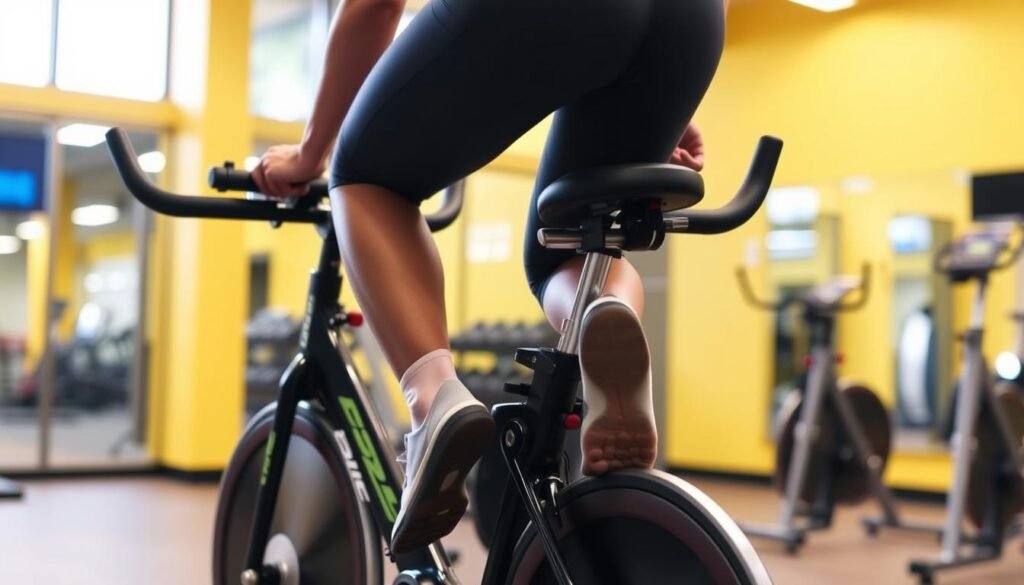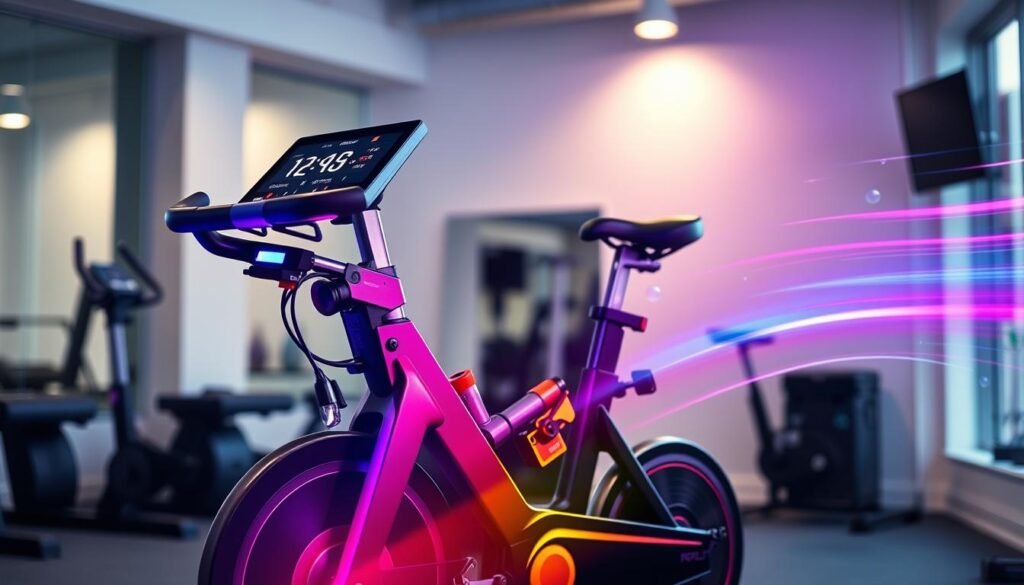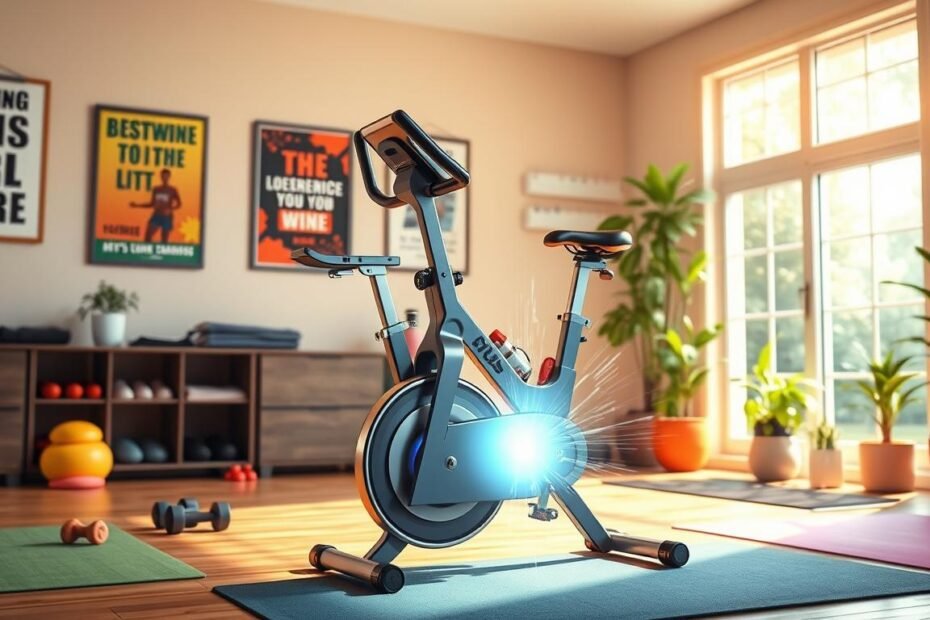When we enter our home gyms, the exercise bike’s quiet hum welcomes us. It’s a trusted companion on our fitness path. We’ve all faced the bike, unsure how to maximize our workouts. Let’s discover how to turn our pedaling into powerful health changes.
Exercise bike workouts are both convenient and effective. They suit everyone, from experienced cyclists to beginners. We’ll explore how indoor cycling can enhance your heart health and strength.
Cycling for fitness is more than just pedaling. A proper warm-up, lasting 5 to 10 minutes, is essential. It gets your body ready, increasing your heart rate and blood flow. This step is crucial for a great workout.
Knowing your training zones is vital for a good exercise bike workout. Zones range from 60-64% of your Threshold Heart Rate (THR) for warm-ups to 95-100% THR for intense sprints. Tailoring your workout to these zones helps you reach your fitness goals faster.
Proper bike setup is also crucial. It ensures you work the right muscles safely. Your seat should be at hip level, with a slight knee bend while pedaling. This setup boosts your power and comfort.
As we learn to master our exercise bikes, remember each pedal stroke moves us closer to our fitness dreams. Stay with us as we dive deeper into indoor cycling. We’ll share techniques and tips to improve your workouts and health.
Understanding the Benefits of Exercise Bike Workouts
Exercise bikes are great for your health, making them a top choice for staying fit. They offer many benefits that make them a key part of any workout plan.
Low-impact cardiovascular exercise
Exercise bikes are easy on your joints but still boost your heart health. The American Heart Association says cycling for 150 minutes a week is good for your heart. This type of workout can lower blood pressure and bad cholesterol.
Strengthening lower body muscles
Cycling works many muscles, like your legs, hips, and back. It can make your lower body stronger and more toned.
Convenience and accessibility
Exercise bikes are super convenient. You can work out anytime, no matter the weather. They come in different styles, like upright, recumbent, and studio bikes, to fit everyone’s needs.
| Exercise Bike Type | Key Features | Best For |
|---|---|---|
| Upright | Similar to outdoor bikes, adjustable resistance | General fitness, weight loss |
| Recumbent | Reclined seat, back support | Joint issues, beginners |
| Studio | Heavy flywheel, high resistance | Intense workouts, experienced riders |
Exercise bikes are a big hit in fitness circles for good reasons. They’re great for your heart, build muscle, and are easy to use. So, if you want to get fit, an exercise bike is a smart choice.
Setting Up Your Exercise Bike for Optimal Performance
Getting your stationary bike set up right is key for a great workout. We’ll cover the important parts of bike positioning to boost your ride.
First, adjust the seat height to match your hipbone. This position lets you pedal with a slight knee bend. Aim for a 5 to 10 degree bend at full extension.
Next, set the seat distance. Your front knee should line up with the pedal’s center when it’s forward. This ensures proper pedaling.
Don’t forget about handlebar height. It should keep your spine neutral. This usually means the handlebars are at saddle height for best power output. Keep your shoulders and hips in line to avoid strain.
Foot positioning is also crucial. Place the ball of your foot over the pedal center for efficient pedaling. If using cycling shoes, make sure they’re aligned and tight for a secure fit.
- Maintain a slight bend in your elbows
- Keep a neutral spine
- Use a soft grip on the handlebars
Remember, there’s no one-size-fits-all for bike positioning. Even people of the same height might need different setups. Adjust your bike as needed for your fitness level, injuries, or joint concerns. By fine-tuning your stationary bike setup, you’ll improve your performance and lower the risk of discomfort or injury.
How to Use an Exercise Bike Effectively
Learning the right way to use an exercise bike is key for a safe and effective workout. We’ll show you how to maintain proper cycling posture, adjust resistance levels, and keep a steady cadence. This will help you get the most out of your sessions.
Proper Positioning and Posture
Getting your cycling posture right is important to avoid injuries and get the best workout. Sit on the widest part of the saddle with your spine straight. Keep your chest up and shoulders back to avoid slouching. Your handlebars should let you extend your arms comfortably at shoulder level.

Adjusting Resistance Levels
Using the right resistance on an exercise bike helps build strength and endurance. If you’re new, start with lower intensity. Then, increase the resistance to make it feel like you’re climbing hills. This will work your hamstrings and glutes better. Most bikes have 12 to 40 resistance levels, so you can change up your workout intensity.
Maintaining a Consistent Cadence
Cadence, or how fast you pedal, is crucial for a good workout. Aim for 70-100 rpm. Changing your cadence during workouts will challenge different muscles and boost your fitness.
| Aspect | Recommendation |
|---|---|
| Seat Height | Leg almost straight at lowest pedal position |
| Handlebar Height | Comfortable arm extension at shoulder level |
| Foot Position | Front half of foot on pedal, straps snug but not tight |
| Posture | Straight spine, chest up, shoulders back |
| Cadence | 70-100 rpm, varied throughout workout |
Crafting an Effective Exercise Bike Routine
Creating a good exercise bike workout routine is crucial for reaching your fitness goals. We’ll look at ways to make your stationary bike sessions better. This includes warm-ups, interval training, and different workout styles.
Warm-up and Cool-down Techniques
Begin each session with a 5-minute warm-up. Pedal at a moderate pace, then increase your speed and resistance. After your workout, cool down for 5 minutes to prevent muscle tightness and promote recovery.

Interval Training for Maximum Results
Add interval training to your exercise bike workouts for better fat-burning and heart health. Alternate between high-intensity sprints and lower-intensity recovery periods. For example, try 30 seconds of all-out effort followed by 90 seconds of easy pedaling. Repeat this cycle 8-10 times for an effective workout.
Incorporating Different Workout Styles
Vary your routines to keep things interesting and challenge different muscle groups. Try these workout styles:
- Hill climbs: Increase resistance to simulate uphill cycling
- Endurance rides: Maintain a steady pace for 30-60 minutes
- HIIT sessions: Short bursts of intense effort with brief rest periods
- Recovery rides: Low-intensity workouts for active rest days
Remember to listen to your body and adjust the intensity as needed. Aim for at least three cardio workouts per week. Combine stationary biking with other activities to prevent burnout. With consistent effort, you’ll soon see improvements in your fitness and endurance levels.
Monitoring Your Progress and Performance
Tracking your fitness journey on an exercise bike is key to reaching your goals. Focus on speed, distance, and power output to see how you’re doing. Fitness tracking apps are great for recording your stats, keeping you motivated.
Beginners should aim for 20-30 minutes of cycling daily in the first week. Then, increase to 45-60 minutes over a few weeks. New riders usually cycle at 10-14 mph, but those with endurance training can hit 15-18 mph.
Challenge yourself by tackling elevation gains of 500-1,000 feet. Adjust your goals as your fitness grows.
Monitoring your performance is crucial for better workouts. Watch your heart rate to see how hard you’re working. But remember, caffeine and temperature can affect it. Functional Threshold Power (FTP) is also important, showing your highest power output for an hour. As your FTP goes up, change your training to keep improving.
